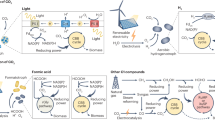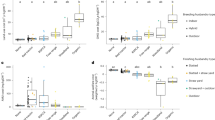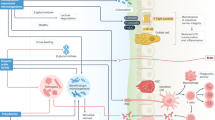Abstract
IN ruminants the heat losses associated with carbohydrate dissimilation amount to 30–70 k.cal./100 k.cal. carbohydrate digested1, whereas in man such losses are only 5–7 k.cal./100 k.cal.2. In calorimetric experiments with fasted sheep, we have found that the steam-volatile fatty acids which are the major end-products of rumen fermentation of carbohydrate produce a greater heat increment than does glucose given under similar conditions, precautions having been taken to minimize bacterial fermentation of the sugar. Furthermore, in starved animals, and also in those receiving food, the energy-loss as heat is considerably greater for acetic acid than for propionic or butyric acids.
This is a preview of subscription content, access via your institution
Access options
Subscribe to this journal
Receive 51 print issues and online access
$199.00 per year
only $3.90 per issue
Buy this article
- Purchase on Springer Link
- Instant access to full article PDF
Prices may be subject to local taxes which are calculated during checkout
Similar content being viewed by others
References
Kellner, O., “Die Ernährung der Landwirtschaftlichen Nutztiere” (9th edit., Parey, Berlin, 1920).
Lusk, G., “The Elements of the Science of Nutrition” (4th edit., W. B. Saunders and Co., Philadelphia and London, 1928).
Blaxter, K. L., Graham, N. McC., and Rook, J. A. F., J. Agric. Sci., 45, 10 (1954).
Gray, F. V., and Pilgrim, A. F., J. Exp. Biol., 28, 83 (1951). Phillipson, A. T., Brit. J. Nutrit., 6, 190 (1952).
Author information
Authors and Affiliations
Rights and permissions
About this article
Cite this article
ARMSTRONG, D., BLAXTER, K. Heat Increments of Feeding in Ruminants. Nature 177, 1183–1184 (1956). https://doi.org/10.1038/1771183b0
Issue Date:
DOI: https://doi.org/10.1038/1771183b0
Comments
By submitting a comment you agree to abide by our Terms and Community Guidelines. If you find something abusive or that does not comply with our terms or guidelines please flag it as inappropriate.



